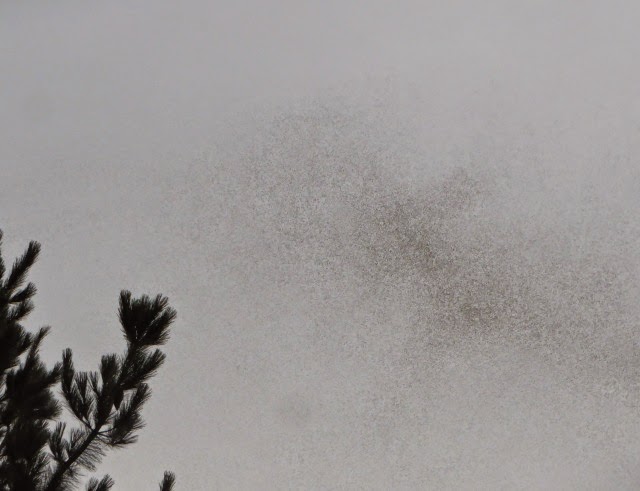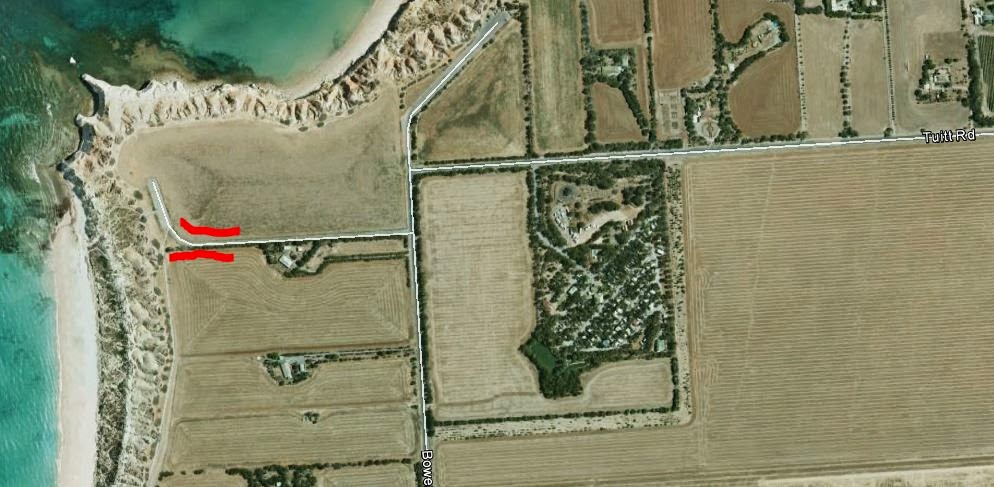Vertebrates of April
One of the major annoyances coming from the wet year in 2010 has been the breeding success of rabbits. Not only have they been munching things in the garden but their appearance causes the small dog to have a noisy meltdown. (This means she tends to give them about 10m lead so thus far she has been unsuccessful in catching one in a straight chase.) However their presence has recently diminished. It may not be a coincidence that this has followed shortly after Frances saw two foxes wandering around the premises.
Since composing the above:
Birds are continuing to be present in good numbers and diversity with over 30 species being seen each week. As usual at this time of year, Red-browed finches have arrived to dine on the grass and weed seeds. They have also had a successful next in a Melaleuca (I think) in the garden: whatever the shrub is the nest is very noisy at meal times!
The birdbath is also continuing to improve its performance . On April 1st there were up to 4 White-browed scrubwrens taking a bath (although only 2 could be captured on SD card).
The scrubbies are becoming the most frequent visitors to the birdbath. It doesn't do much for their appearance (although they still look lively in a Ginger meggsish way).
For the past few weeks we have been graced with the presence of 1 -2 Eastern Yellow Robins (EYR) . I, and some well known local naturalists, tend to regard them as wet forest birds which may explain why they tend to hang out close to a Cupressus windbreak. This afternoon one posed for a piccie.
Reflecting back to the previous topic here is an EYR contemplating a bath (which it eventually took).
A somewhat unusual sight was a small skink (of unknown species) struggling in a rose bush in the garden. It seems that it had been trapped in a remnant spider web and once I freed up the web it took off. When we installed our snake repellers a neighbour asked if they would keep away lizards. (Knowing them, they would see lizard repelling as a Bad Thing. I would tend to agree with them but given a choice between {Lots of lizards and lots of snakes} or {No lizards nor snakes} I'd take the latter.) Anyway their question has been answered:
The glassy surface is the solar panel of the repeller! As far as I can work out the lizard is a Garden skink Lampropholis guitchenoti. here is a closer shot of the same species in a garden bed.
On the subject of snakes, as the weather cools down I expect them to disappear into nice deep holes for Winter. It hasn't happened yet as I came across a 1m long ex Eastern Brown Snake in the middle of Widgiewa Rd on 5 April. I flicked the corpse off the road so as not to alarm anyone and it was still flexible so I guess a recent transfer to The Other Side.
One should not reject the commonplace, since it may not be common to some readers. Here is an Australian Magpie (a bit of colonial mislabelling - other than being black and white it is nothing to do with Northern hemisphere magpies) sitting on the fence around the vegie garden.
The next two images are of Scarlet Robins. More mislabelling: nothing to do with either European or North American Robins (which are in the Thrush family, unless the evil forces of taxonomy have changed things). These are more like Flycatchers. The first image is the female (note relatively low level of luridity) and the second is the male.
Given that in both cases the birds were 5m up a tree, and about 8m away from me (and they are not big birds to start with) I am pretty impressed with the performance of my camera.
Since composing the above:
- I have found one badly injured rabbit (no idea how it got the injury, but I put it out of its misery promptly);
- two have been caught in the cat trap (ibid); and
- the small dog nailed one in the vegie garden.
Birds are continuing to be present in good numbers and diversity with over 30 species being seen each week. As usual at this time of year, Red-browed finches have arrived to dine on the grass and weed seeds. They have also had a successful next in a Melaleuca (I think) in the garden: whatever the shrub is the nest is very noisy at meal times!
The birdbath is also continuing to improve its performance . On April 1st there were up to 4 White-browed scrubwrens taking a bath (although only 2 could be captured on SD card).
The scrubbies are becoming the most frequent visitors to the birdbath. It doesn't do much for their appearance (although they still look lively in a Ginger meggsish way).
For the past few weeks we have been graced with the presence of 1 -2 Eastern Yellow Robins (EYR) . I, and some well known local naturalists, tend to regard them as wet forest birds which may explain why they tend to hang out close to a Cupressus windbreak. This afternoon one posed for a piccie.
Reflecting back to the previous topic here is an EYR contemplating a bath (which it eventually took).
A somewhat unusual sight was a small skink (of unknown species) struggling in a rose bush in the garden. It seems that it had been trapped in a remnant spider web and once I freed up the web it took off. When we installed our snake repellers a neighbour asked if they would keep away lizards. (Knowing them, they would see lizard repelling as a Bad Thing. I would tend to agree with them but given a choice between {Lots of lizards and lots of snakes} or {No lizards nor snakes} I'd take the latter.) Anyway their question has been answered:
The glassy surface is the solar panel of the repeller! As far as I can work out the lizard is a Garden skink Lampropholis guitchenoti. here is a closer shot of the same species in a garden bed.
On the subject of snakes, as the weather cools down I expect them to disappear into nice deep holes for Winter. It hasn't happened yet as I came across a 1m long ex Eastern Brown Snake in the middle of Widgiewa Rd on 5 April. I flicked the corpse off the road so as not to alarm anyone and it was still flexible so I guess a recent transfer to The Other Side.
One should not reject the commonplace, since it may not be common to some readers. Here is an Australian Magpie (a bit of colonial mislabelling - other than being black and white it is nothing to do with Northern hemisphere magpies) sitting on the fence around the vegie garden.
The next two images are of Scarlet Robins. More mislabelling: nothing to do with either European or North American Robins (which are in the Thrush family, unless the evil forces of taxonomy have changed things). These are more like Flycatchers. The first image is the female (note relatively low level of luridity) and the second is the male.
Given that in both cases the birds were 5m up a tree, and about 8m away from me (and they are not big birds to start with) I am pretty impressed with the performance of my camera.













Comments